
Original Link: https://www.anandtech.com/show/1928
Part 1 of the 2GB DDR Kit Roundup took a close look at 3 memories based on Infineon memory chips. Since that review in October, a number of 2GB DDR kits have appeared in the market with most based on Infineon C or B die memory chips. There are, however, a few brands that have taken a different approach to memory chips for 1GB DIMMs, and we have included those in this roundup, along with the latest Infineon-based memories.
1GB DDR DIMMs began appearing in the market over a year ago, but it wasn't until mid-2005 that 1GB DIMMs with reasonably fast timings became widely available. These faster 1GB DIMMs finally made the choice of 2GB memory kits to be a reasonable choice in a market that had been dominated by fast DDR 512MB DIMMs.
There are many reasons to choose a 2GB kit over a 1GB kit or 4 512MB DIMMs. Two 1GB DIMMs on the AMD Athlon 64 can still run at 1T Command rate, instead of the 2T required by the 4x512MB DIMMs needed for 2GB with 512MB DIMMs - a definite advantage for the 1GB DIMMs. On the other hand, until recently, the available 1GB DIMMs were generally much slower than the fast 2-2-2 DIMMs that were commonly available in 512MB DIMMs. We normally saw 3-3-3 or 3-4-4 or slower timings for 1GB DIMMs. These poorer timings for 1GB DIMMs took away most of the advantage for the 1GB 1T Command Rate.
There was an additional "gotcha" with the 1GB DIMMs that many enthusiasts quickly discovered. With a starting point of 3-3-3 or 3-4-4 at DDR400, the 1GB parts did not overclock nearly as far as the 512MB parts. For all of these reasons, we generally recommended that most users were better off with 512MB DIMMs - at least until memory timings improved on the 1GB DIMMs.
The time for faster 1GB DIMMs has finally come in the past 6 months, and they are now available from almost every memory manufacturer. In Part 1, we looked at three 2GB kits from Corsair, Gigaram, and OCZ. In this part 2, we put six additional fast 2GB kits through our test bench, with some interesting results. We also updated some parts of our memory test bench, which required retesting of the original three 2GB kits.
Our memory tests differentiate memory in two ways. First, AnandTech has always been an advocate of real world performance measurements, and we've shunned using just synthetic benchmarks in our testing of every type of component, including memory. This is not because synthetic benchmarks are not useful - they are often very revealing of component differences - but rather, it is because running just synthetic benchmarks can severely distort the picture of performance with real applications and real games. That is why we always use games and the pure number-crunching Super Pi in our memory tests. It is also the reason why we test using both Buffered (Standard) and Unbuffered synthetic benchmarks. We have found in much of our testing that the less commonly used Unbuffered benchmarks mirror more closely how games really respond to memory differences.
Second, we moved to testing different memory speeds at the same CPU clock speed in our Athlon 64 memory tests. The AMD CPU, with unlocked multipliers, allowed us to finally remove the CPU speed differences from our memory tests. This allows you to finally see the true impact of memory speed increases and memory timings on performance. As you have seen in past reviews, those performance differences are very real, although they are much smaller than what many memory manufacturers might want you to believe. On the other hand, faster memory speeds and faster memory timings do improve performance, no matter what some nay-sayers are determined to prove.
The New 2GB DDR Kits
The six new kits fall into 2 groups: three kits are rated at DDR400 and three are rated at DDR500.
| Manufacturer | Description (Memory Chips) |
Memory Speed | Rated Timings | Voltage |
| Corsair | TWINX2048-4000PT (Samsung UCCC) |
500DDR | 3-4-4-8 | 2.6V |
| Crucial | CLIII5N.32 PN56278 (Micron) |
500DDR | 3-3-3-8 | 2.6V |
| G. Skill | F1-3200PHU2-2GBZX (Infineon B Die) |
400DDR | 2-3-2-5 | 2.6V |
| Kingston | KHX3200AK2/2G (Probably Infineon B Die) |
400DDR | 2.5-3-3-7 | 2.6V |
| Mushkin | 2GB Redline XP4000 (Infineon C die) |
500DDR | 3-3-2-8 | 2.6V |
| Team | XTreem TXDR 1024M400HC2 (Infineon B die) |
400DDR | 2-3-3-5 | 2.6V |
Two of the DDR400 parts, from G. Skill and Kingston, appear to be based on Infineon B die memory chips, BE5 or BE6. The third DDR400 from Team reached a higher DDR533, but is still likely based on the Infinity B die. The Infineon B die normally performs very well to the DDR480 to DDR 500 range. The DDR500 kit from Mushkin is likely based on Infineon C die memory chips, CE5 or CE6. The C die chips are nearly as fast at slower memory speeds as B die, but they overclock further to the DDR550 to DDR580 range.
Crucial is the marketing arm of Micron, so Crucial is the only 2GB kit featuring Micron memory chips. The Micron-based 2GB chip performs exceptionally well, but availability has been an issue since the Crucial 2GB kit was first introduced. Apparently, yields have been and remain an issue with this 2GB kit.
Corsair submitted a "Value" DDR500 2GB kit for Part 2 that is based on Samsung UCCC memory chips. The Samsung parts are about 60% the price of Infineon 2GB kits. Corsair tells us that the chips are a bit slower in memory timings, but the overclocking capabilities are very good - matching or exceeding the OC capabilities of the Infineon 2GB kits.
This is a very wide range of 2GB kits, and with the retest of our three earlier kits, we will have results from nine 2GB kits to help you choose the 2GB DDR kit that is right for your needs and budget.
Performance Test Configuration
The six 2GB kits were tested with the DFI LANParty nF4 SLI-DR Athlon 64 Socket 939 motherboard. Other components remain the same as used in the memory setup in Athlon 64 Memory: Rewriting the Rules.
The A64 test bed includes components that have been proven in Socket 939 Athlon 64 benchmarking, such as the Socket 939 90nm 4000+, the OCZ Power Stream 520 Power Supply, and the NVIDIA 7800 GTX video card. We used an AMD 4000+ 90nm processor with a Revision E type memory controller. All other basic test conditions attempted to mirror those used in our earlier Athlon 64 memory reviews.
Since the video card, and platform/video drivers are upgraded from past memory testing, we found that the results were not completely consistent with past memory test results. For that reason, we retested the three 2GB kits that were previously tested. Results are still broadly comparable to past memory test results in earlier reviews, but we decided to include just the nine 2GB kit results in this roundup.
| AMD nForce4 Performance Test Configuration | |
| Processor(s): | AMD 4000+ Athlon 64(90nm) 2.4GHz, Socket 939, 1 MB cache, Dual Channel, 1000HT |
| RAM: | TWINX2048-4000PT (DS) 2X1GB Crucial Ballistix CLIII5N.32 (DS) 2X1GB G. Skill F1-3200PHU2-2GBZX (DS) 2X1GB KHX3200AK2/2G (DS) 2X1GB Mushkin 2GB Redline XP4000 (DS) 2X1GB Team XTreem TXDR 1024M400HC2 (DS) 2X1GB Corsair TWINX2048-3500XL PRO (DS) 2X1GB Gigaram 2GB Dual Channel PC-4200 (DS) 2X1GB OCZ PC4000 2x1024MB EB Platinum (DS) 2X1GB |
| Hard Drives: | Seagate 120GB SATA 7200RPM 8MB Cache |
| PCI/AGP Speed: | Fixed at 33/66 |
| Bus Master Drivers: | NVIDIA nForce Platform Driver 6.70 |
| Video Card(s): | NVIDIA 7800 GTX 256MB PCIe, 256MB aperture, 1024x768x32 |
| Video Drivers: | NVIDIA Forceware 81.98 Release |
| Power Supply: | OCZ Power Stream 520W |
| Operating System(s): | Windows XP Professional SP2 |
| Motherboard: | DFI LANParty nF4 SLI-DR |
| BIOS: | 7/06/2005 |
As discussed in other memory reviews, we ran a complete set of Memtest86 benchmarks with only tRAS varied to determine the best tRAS setting for these memories on the nForce4 chipset. The NVIDIA nForce4 has the best bandwidth at tRAS settings ranging from 5 to 8. Therefore, a tRAS setting of 7 was used for testing.
Test Settings
All AMD Athlon 64 processors are unlocked downward, and the FX CPUs are unlocked up and down. This feature allows a different approach to memory testing, which truly measures performance differences in memory speed alone. All tests were run with CPU speed as close to the specified 2.4GHz of the 4000+ as possible, with CPU speed/Memory Speed increased at lower multipliers to achieve 2.4 GHz. This approach allows the true measurement of the impact of higher memory speed and timings on performance, since CPU speed is fixed, removing CPU speed as a factor in memory performance.
The following settings were tested with the six 2GB kits on the DFI nF4 test bed:
- 2.4GHz-12x200/DDR400 - the highest stock memory speed supported on nF3-4/SiS755-FX/ATI Radeon Xpress 200/VIA 939 motherboards
- 2.4GHz-11x218/DDR436 - a ratio near the standard DDR433 speed
- 2.4GHz-10x240/DDR480 - a ratio near the standard rating of DDR466
- 2.4GHz-9x267/DDR533 - a memory speed achieved by only a few top memories on the Athlon 64
- 2.4GHz-8x300/DDR600 - with recent improvements in OC abilities, a very few memories can reach this next multiple with the 8 multiplier
- Highest Memory Performance - the highest memory bandwidth and game performance that we could achieve with the memory being tested. This is the highest memory speed that we could achieve with 1T Command Rate.
Corsair TWINX2048-4000PT
Corsair is the most widely recognized brand of Enthusiast or high-performance memory in the world. Corsair also maintains very visible support in the form of RamGuy, who provides support for Corsair products at www.asktheramguy.com and as a participant in many Forums.
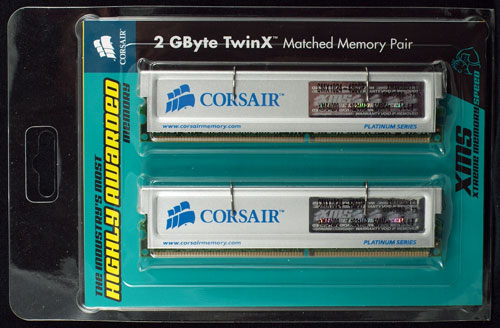
The 4000PT include matte silver-colored aluminum heatspreaders that are appropriate for the Corsair Platinum series. There are no LEDs or diagnostic strips that would increase the cost of the 2GB kit. Corsair also markets an Expert line of DIMMs, which include programmable LEDs that can display memory speed, memory voltage, and other useful memory diagnostic data if that is an important feature for the buyer. The 3500LL PRO that we reviewed in Part 1 of the 2GB roundup used Infineon memory and featured diagnostic LEDs. Whatever you are looking for in your 2GB memory purchase is likely available as a Corsair product.
Specifications
The TWINX2048-4000PT is rated at CAS3 at DDR500, with slow rated timings of 3-4-4-8 at default voltage.
| Corsair TWINX2048-4000PT Memory Specifications | |
| Number of DIMMs & Banks | 2 DS |
| DIMM Size Total Memory |
1GB 2GB |
| Rated Timings | 3-4-4-8 at DDR500 |
| Rated Voltage | Standard (2.6V) Voltage |
| SPD | 3-3-3-8 |
Test Results
| Corsair TWINX2048-4000PT (DDR500) - 2x1GB Double-Bank | |||||||
| CPU Ratio at 2.4GHz | Memory Speed |
Memory Timings & Voltage |
Quake3 fps |
Sandra UNBuffered | Sandra Standard Buffered |
Super PI 2M places (time in sec) |
Wolfenstein - Radar - Enemy Territory fps |
| 12x200 | 400DDR | 2.5-3-3-7 2.5V |
528.3 | INT 2448 FLT 2599 |
INT 6001 FLT 5973 |
83 | 116.0 |
| 11x218 | 436DDR | 2.5-3-3-7 2.6V |
536.2 | INT 2592 FLT 2741 |
INT 6427 FLT 6345 |
83 | 117.3 |
| 10x240 | 480DDR | 2.5-3-3-7 2.7V |
549.0 | INT 2796 FLT 2910 |
INT 6703 FLT 6642 |
81 | 119.3 |
| 9x266 | 533DDR | 3-4-4-8 2.7V |
545.0 | INT 2844 FLT 3088 |
INT 6960 FLT 6880 |
81 | 118.9 |
| 9x290 (2.61GHz) |
Highest Mem Speed DDR 580 |
3-4-4-8 2.8V |
580.8 | INT 3201 FLT 3357 |
INT 7542 FLT 7393 |
74 | 128.6 |
Despite the somewhat slow rated timings of the Corsair 4000PT, the memory managed to work fine at faster timings at almost every speed setting. While it is not included in the chart, we were able to run at the rated DDR500 speed at 3-3-3-8 timings at 2.8V instead of the specified 3-4-4-8 timings. The Corsair 4000PT is not the fastest 2GB memory in the roundup, but it manages to perform within a few frames of the fastest 2GB kits at every tested speed. In addition, the 4000PT turned out to be a really excellent overclocker, reaching a stable DDR580 speed.
While this Corsair kit will not satisfy those who want the fastest 2GB kit available, the 4000PT will be a good choice for those who are willing to give up a few frames at each speed in exchange for a 30% to 40% lower price. The one thing that you won't have to give up is great overclocking capabilities, since this Corsair is one of the most overclockable 2GB kits in the roundup.
Crucial Ballistix CLIII5N.32 PN56278
As the retail sales arm of Micron, the huge memory chip manufacturer, Crucial has managed to impress us many times with their high-end Ballistix memory line. The Ballistix name is almost always means high performance, but it also normally represents good value in the memory market.
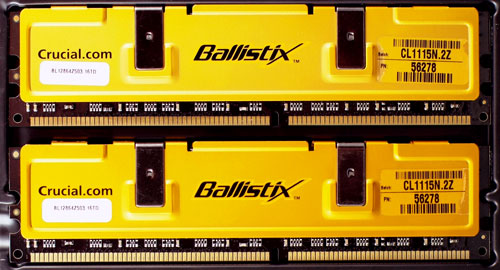
Specifications
The Crucial Ballistix 2GB kit is rated at DDR500 at the somewhat conservative ratings of 3-3-3-8. We actually found that the DIMMs would run at much better timings at DDR500. We could run the DDR500 speed at 2.5-2-2-7 at 2.8V, which is the best performance that we have ever seen at DDR500 with 1GB DIMMs.
| Crucial Ballistix CLIII5N.32 PN56278 Memory Specifications | |
| Number of DIMMs & Banks | 2 DS |
| DIMM Size Total Memory |
1GB 2GB |
| Rated Timings | 3-3-3-8 at DDR500 |
| Rated Voltage | Standard (2.6V) Voltage |
| SPD | 3-3-3-8 |
Voltage is rated at standard or 2.6V.
Test Results
| Crucial Ballistix CLIII5N.32 (DDR500) - 2x1GB Double-Bank | |||||||
| CPU Ratio at 2.4GHz | Memory Speed |
Memory Timings & Voltage |
Quake3 fps |
Sandra UNBuffered | Sandra Standard Buffered |
Super PI 2M places (time in sec) |
Wolfenstein - Radar - Enemy Territory fps |
| 12x200 | 400DDR | 2-2-2-7 2.6V |
545.2 | INT 2601 FLT 2724 |
INT 6082 FLT 6029 |
82 | 118.9 |
| 11x218 | 436DDR | 2.5-2-2-7 2.6V |
545.0 | INT 2724 FLT 2824 |
INT 6449 FLT 6386 |
81 | 118.8 |
| 10x240 | 480DDR | 2.5-2-2-7 2.7V |
556.9 | INT 2857 FLT 3033 |
INT 6736 FLT 6656 |
80 | 120.6 |
| 9x267 | 533DDR | 3-3-3-7 2.7V |
553.8 | INT 2991 FLT 3171 |
INT 6971 FLT 6871 |
80 | 120.3 |
| 8x300 | 600DDR | 3-4-4-8 2.8V |
561.2 | INT 3186 FLT 3335 |
INT 7173 FLT 7078 |
80 | 121.5 |
| 9x305 (2.75GHz) |
Highest Mem Speed DDR 610 |
3-4-4-8 2.8V |
618.6 | INT 3420 FLT 3574 |
INT 8000 FLT 7901 |
71 | 135.1 |
Crucial Ballistix has been available for several months and the performance characteristics are pretty well known. We achieved incredible results with our Crucial Ballistix, but our results should be considered among the best that you can achieve with these 1GB DIMMs. Where we were able to run at 2-2-2 timings at stock voltage, we more commonly see results at DDR400 of 2-3-2. This is not to take anything away from the Ballistix 2GB kit, as it is definitely an incredible performer at the more normal results that we see in Forums.
One word of caution: some users have been killing their Crucial Ballistix 2GB kits. It appears that the culprit is high memory voltages. We did a survey of a number of Forums and found that, in most cases, the memory was dying at voltages of 2.85V and higher. Our advice, which we also followed in benchmarking for this review, is to keep voltages below 2.85V with the 2GB Crucial Ballistix kits.
The other end of the spectrum was also outstanding for Ballistix. We reached a stable DDR610 overclock at 2.8V with the 2GB kit. This is the highest overclock achieved with any of the nine 2GB kits tested in this review. Our only real reservation with Ballistix is the spotty availability that has characterized this product since launch. This "on again, off again" availability is usually an indication that yields may not be as good as a manufacturer would like. We don't know the real reasons why 2GB Ballistix doesn't stay in stock, but you should be aware of the supply problems before deciding on this 2GB kit.
G. Skill F1-3200PHU2-2GBZX
G. Skill entered the US market at about the time that Samsung TCCD memory was launched. G. Skill capitalized on the incredible performance of TCCD and produced some excellent TCCD parts that were marketed to enthusiasts on many Forums. We reviewed the early TCCD in PQI & G. Skill: New Choices in 2-2-2 Memory and found that the G. Skill performed very well.
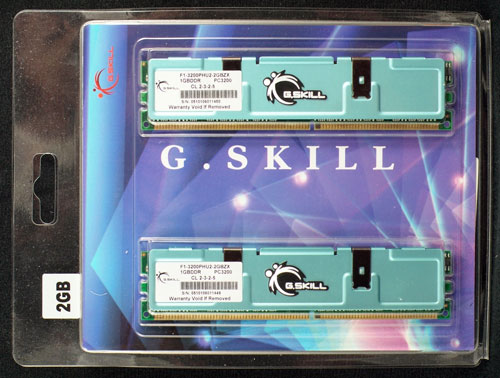
Specifications
G. Skill rates their 1GB DIMMs at DDR400, which is usually an indication that B die Infineon memory chips were used.
| G. Skill F1-3200PHU2-2GBZX Memory Specifications | |
| Number of DIMMs & Banks | 2 DS |
| DIMM Size Total Memory |
1GB 2GB |
| Rated Timings | 2-3-2-5 at DDR400 |
| Rated Voltage | Standard (2.6V) Voltage |
| SPD | 2-3-2-5 |
Test Results
| G. Skill F1-3200PHU2-2GBZX (DDR400)- 2x1GB Double-Bank | |||||||
| CPU Ratio at 2.4GHz | Memory Speed |
Memory Timings & Voltage |
Quake3 fps |
Sandra UNBuffered | Sandra Standard Buffered |
Super PI 2M places (time in sec) |
Wolfenstein - Radar - Enemy Territory fps |
| 12x200 | 400DDR | 2-3-2-7 2.5V |
539.5 | INT 2527 FLT 2669 |
INT 6033 FLT 6016 |
82 | 117.6 |
| 11x218 | 436DDR | 2.5-3-2-7 2.6V |
541.2 | INT 2664 FLT 2802 |
INT 6438 FLT 6367 |
82 | 118.2 |
| 10x240 | 480DDR | 2.5-3-2-7 2.7V |
552.2 | INT 2806 FLT 3018 |
INT 6715 FLT 6632 |
81 | 119.3 |
| 9x258 (2.32GHz) |
516DDR | 3-3-2-8 2.8V |
535.7 | INT 2969 FLT 3132 |
INT 6739 FLT 6646 |
82 | 116.3 |
| 10x258 (2.58GHz) |
Highest Mem Speed DDR 516 |
3-3-2-8 2.8V |
571.0 | INT 3041 FLT 3241 |
INT 7179 FLT 7117 |
75 | 127.8 |
Test results also point to Infineon B die chips. The G. Skill 2GB kit is very fast from DDR400 to the highest stable overclock that we could achieve at DDR516. This is a very high overclock for B die Infineon memory, showing G. Skill has not lost their expertise in squeezing the most out of the memory chips that they use. If fast performance with 1GB DIMMs from DDR400 to DDR500 will meet your goals, then the G. Skill 2GB kit is a good choice. The only problem, compared to other 2GB kits, is that C die Infineon is just as fast at lower speeds, but C die continues to overclock to DDR550 to 580.
Like the Corsair Infineon B die that we reviewed in Part 1, the G. Skill is a memory that does not need a special board with super high voltages to get the best from the memory. You can get the best from these 1GB with almost any decent motherboard, since we never needed more than 2.8V for stable performance at any speed.
Kingston KHX3200AK2/2G
Kingston is the world's largest manufacturer of computer memory, with manufacturing plants around the world. If it's memory, Kingston has it in their catalog. That even includes high-end, enthusiast memory that Kingston markets under the HyperX name.
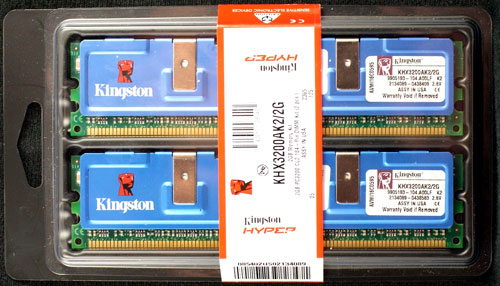
Specifications
Kingston rates their 2GB kit conservatively at 2.5-3-3 at DDR400, at standard voltage.
| Kingston KHX3200AK2/2G Memory Specifications | |
| Number of DIMMs & Banks | 2 DS |
| DIMM Size Total Memory |
1GB 2GB |
| Rated Timings | 2.5-3-3-7 at DDR400 |
| Rated Voltage | Standard (2.6V) Voltage |
| SPD | 3-3-3-8 |
When we first saw these published specifications, we suspected that Kingston might be using a new memory chip for this 2GB kit. However, you will see in the test results that the actual performance is a mirror of how we have come to expect Infineon B die to perform.
Test Results
| Kingston KHX3200AK2/2G (DDR400) - 2x1GB Double-Bank | |||||||
| CPU Ratio at 2.4GHz | Memory Speed |
Memory Timings & Voltage |
Quake3 fps |
Sandra UNBuffered | Sandra Standard Buffered |
Super PI 2M places (time in sec) |
Wolfenstein - Radar - Enemy Territory fps |
| 12x200 | 400DDR | 2-3-2-7 2.6V |
539.2 | INT 2511 FLT 2648 |
INT 6040 FLT 6008 |
82 | 117.6 |
| 11x218 | 436DDR | 2.5-3-2-7 2.6V |
541.9 | INT 2648 FLT 2811 |
INT 6435 FLT 6382 |
82 | 118.0 |
| 10x240 | 480DDR | 3-3-3-7 2.8V |
550.1 | INT 2830 FLT 2908 |
INT 6675 FLT 6602 |
81 | 119.1 |
| 11x240 (2.64GHz) |
Highest Mem Speed DDR 480 |
3-3-3-7 2.8V |
561.7 | INT 2846 FLT 3001 |
INT 7079 FLT 6984 |
77 | 125.3 |
While rated at 2.5-3-3, our Kingston 2GB HyperX performed at DDR400 at 2-3-2 timings - much better than rated. Performance was good all the way to DDR480, but we could not achieve stable performance at any setting above DDR480. This was the poorest overclock among the nine 2GB kits tested in this roundup.
In the range from DDR400 to DDR480, the Kingston HyperX 2GB kit is competitive with any of the other memories. If that range is all that is required, the HyperX will do an excellent job. If you want greater overclocking abilities, however, you need to look at one of the other eight memories tested in this roundup. Kingston HyperX is often an excellent value in the memory market. It is also worthwhile to compare pricing of the Kingston 2GB kit to competitors' pricing.
Mushkin 2GB Redline XP4000
Mushkin is a very well-known brand of Enthusiast memory. Most computer hobbyists know Mushkin for their web-based direct memory sales, based in Denver, CO. Direct sales have always been a large part of Mushkin's business, but today, you can buy Mushkin memory at Newegg and other web e-tailers as well.
Several months ago, Mushkin introduced their new Redline heatspreader. With large slots in the top of the heatspreader, it was designed to better dissipate heat than the older closed heatspreaders, which often caused higher temperatures than no heatspreader at all.
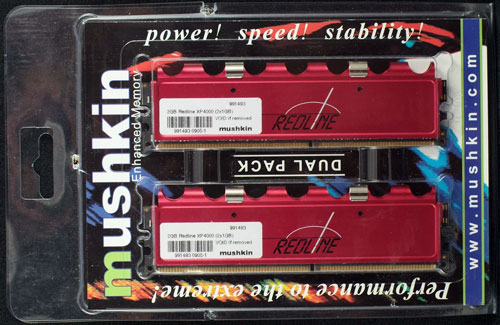
Specifications
Mushkin rates their DDR500 2GB Redline kit at 3-3-2 timings at DDR500. Those are exactly the timings that we would expect with Infineon C die memory.
| Mushkin 2GB Redline XP4000 Memory Specifications | |
| Number of DIMMs & Banks | 2 DS |
| DIMM Size Total Memory |
1GB 2GB |
| Rated Timings | 3-3-2-8 at DDR500 |
| Rated Voltage | Standard (2.6V) Voltage |
| SPD | 3-3-2-8 |
Voltage is rated at standard 2.6V, so you will not need a board with super high vCore to get the most from these memory chips.
Test Results
| Mushkin 2GB Redline XP4000 (DDR500) - 2x1GB Double-Bank | |||||||
| CPU Ratio at 2.4GHz | Memory Speed |
Memory Timings & Voltage |
Quake3 fps |
Sandra UNBuffered | Sandra Standard Buffered |
Super PI 2M places (time in sec) |
Wolfenstein - Radar - Enemy Territory fps |
| 12x200 | 400DDR | 2-3-2-7 2.5V |
538.5 | INT 2516 FLT 2658 |
INT 6027 FLT 6027 |
82 | 117.5 |
| 11x218 | 436DDR | 2-3-2-7 2.7V |
545.0 | INT 2687 FLT 2831 |
INT 6448 FLT 6375 |
81 | 118.5 |
| 10x240 | 480DDR | 2.5-3-2-7 2.6V |
549.0 | INT 2852 FLT 3017 |
INT 6721 FLT 6651 |
80 | 119.6 |
| 9x267 | 533DDR | 3-3-2-7 2.7V |
557.3 | INT 3090 FLT 3165 |
INT 7005 FLT 6923 |
80 | 120.8 |
| 9x293 (2.64GHz) |
Highest Mem Speed DDR 586 |
3-3-2-7 2.8V |
593.0 | INT 3299 FLT 3536 |
INT 7658 FLT 7548 |
73 | 129.6 |
The performance of the Mushkin Redline was typically Infineon C, except it was always at the better end of expected C die performance. Mushkin managed DDR436 at CAS2, where some other Infineon chip memory requires CAS2.5. Even at the very top, the Redline ran with complete stability at 3-3-2 timings and never required more than 2.8V for best performance.
The highest overclock with Mushkin Redline was an outstanding DDR586 - the highest overclock of any Infineon based 2GB kit in this review. In fact, only the impossible to buy Crucial Ballistix could reach further. All-in-all, Mushkin Redline was a top performer, achieving the kind of performance and overclocking that will likely satisfy even the most jaded new user of 1 GB DIMMs. Mushkin, like OCZ in Part 1 of the 2GB kit roundup, makes the most of the memory chips used in their memory kits. Effective binning and good quality assurance pay off in a consistent, high-performing 2GB memory kit.
Team XTreem TXDR 1024M400HC2
Team will be another new name to our readers, but the company already has a world-wide presence with manufacturing in Asia and US Sales Offices.
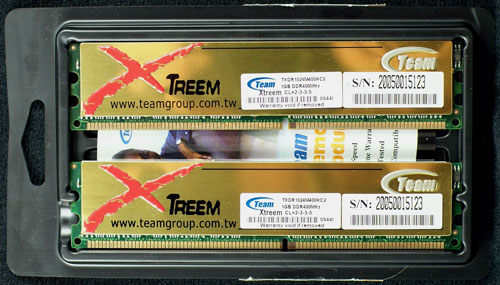
Specifications
The Team 2GB kit is another DDR400 rated memory kit, which, as expected, features Infineon chips.
| Team XTreem TXDR 1024M400HC2 Memory Specifications | |
| Number of DIMMs & Banks | 2 DS |
| DIMM Size Total Memory |
1GB 2GB |
| Rated Timings | 2-3-3-5 at DDR400 |
| Rated Voltage | Standard (2.6V) Voltage |
| SPD | 2-3-3-5 |
As we have seen with all the new 2GB kits, high memory voltage is not required to get the most from the 2GB kits. Team also rates their kit at standard voltage, and we never required more than 2.8V to get the most performance from the 2GB kit.
Test Results
| Team XTreem TXDR 1024M400HC2 (DDR400) - 2x1GB Double-Bank | |||||||
| CPU Ratio at 2.4GHz | Memory Speed |
Memory Timings & Voltage |
Quake3 fps |
Sandra UNBuffered | Sandra Standard Buffered |
Super PI 2M places (time in sec) |
Wolfenstein - Radar - Enemy Territory fps |
| 12x200 | 400DDR | 2-3-2-7 2.5V |
540.9 | INT 2502 FLT 2630 |
INT 6034 FLT 6018 |
82 | 117.9 |
| 11x218 | 436DDR | 2-3-2-7 2.7V |
545.0 | INT 2661 FLT 2825 |
INT 6462 FLT 6372 |
81 | 118.6 |
| 10x240 | 480DDR | 2.5-3-2-7 2.6V |
554.3 | INT 2853 FLT 3040 |
INT 6722 FLT 6650 |
81 | 120.2 |
| 9x267 | 533DDR | 3-3-2-8 2.8V |
558.0 | INT 3044 FLT 3247 |
INT 7003 FLT 6941 |
80 | 121.2 |
| 10x267 (2.67GHz) |
Highest Mem Speed DDR 533 |
3-3-2-8 2.8V |
590.9 | INT 3175 FLT 3388 |
INT 7868 FLT 7857 |
76 | 132.2 |
The DDR400 rating would lead us to believe that these are Infineon B die chips, and if they are, Team has done an excellent job in binning chips and designing their PCB and SPD. That's because Team Xtreem reaches the highest overclock that we have seen with a DDR400 rated 2GB kit.
Memory timings are what we would expect with a well-designed Infineon chip-based memory, and the Team overclocks all the way to DDR533. To repeat, this is the highest overclock in the roundup for a memory rated at DDR400.
The Team name may not be familiar to you, but you should definitely add Team to your shopping list. These are solid DDR400 Infineon DIMMs and if the price is right, you will not be disappointed in your new memory purchase. It is true that Infineon C die reaches a bit further if properly binned, but the difference between the TEAM at 533 and C die at 550 or higher is not that big. Other DDR400 rated Infineon DIMMs in this roundup often struggled to even approach DDR500 in their overclocks.
Updated Benchmarks - Corsair, Gigaram, OCZ
With the update of the Memory Test Bench to the NVIDIA 7800 GTX and newer platform/video drivers, results from our previous benchmarks of 2GB kits in 1GB DIMMs: FAST 2GB DDR Kits from Corsair, Gigaram, and OCZ were not directly comparable. All benchmarks were rerun on these three memories so results could be directly compared to the six new 2GB kits.
Corsair TWINX2048-3500LLPRO (DDR433)
| Corsair TWINX2048-3500LLPRO (DDR433) - 2x1GB Double-Bank | |||||||
| CPU Ratio at 2.4GHz | Memory Speed |
Memory Timings & Voltage |
Quake3 fps |
Sandra UNBuffered | Sandra Standard Buffered |
Super PI 2M places (time in sec) |
Wolfenstein - Radar - Enemy Territory fps |
| 12x200 | 400DDR | 2-3-2-7 2.5V 1T |
536.3 | INT 2540 FLT 2687 |
INT 6103 FLT 6036 |
82 | 117.8 |
| 11x218 | 436DDR | 2-3-2-7 2.6V 1T |
545.1 | INT 2704 FLT 2861 |
INT 6433 FLT 6363 |
82 | 118.5 |
| 10x240 | 480DDR | 2.5-3-2-7 2.7V 1T |
551.7 | INT 2862 FLT 3007 |
INT 6698 FLT 6614 |
81 | 119.5 |
| 10x246 (2.46GHz) |
Highest Mem Speed DDR 492 |
2.5-3-2-7 2.7V 1T |
563.8 | INT 2928 FLT 3110 |
INT 6832 FLT 6813 |
80 | 122.6 |
Gigaram 2GB Dual Channel PC-4200 (DDR533)
| Gigaram 2GB Dual Channel PC-4200 (DDR533) - 2x512Mb Double-Bank | |||||||
| CPU Ratio at 2.4GHz | Memory Speed |
Memory Timings & Voltage |
Quake3 fps |
Sandra UNBuffered | Sandra Standard Buffered |
Super PI 2M places (time in sec) |
Wolfenstein - Radar - Enemy Territory fps |
| 12x200 | 400DDR | 2-3-2-7 2.5V 1T |
537.9 | INT 2536 FLT 2687 |
INT 6072 FLT 6028 |
82 | 117.4 |
| 11x218 | 436DDR | 2.5-3-2-7 2.7V 1T |
544.3 | INT 2685 FLT 2822 |
INT 6424 FLT 6362 |
82 | 118.4 |
| 10x240 | 480DDR | 2.5-3-2-7 2.8V 1T |
550.7 | INT 2796 FLT 2895 |
INT 6703 FLT 6628 |
81 | 119.8 |
| 9x267 | 533DDR | 3-3-3-7 2.9VV 1T |
549.8 | INT 3012 FLT 3237 |
INT 6964 FLT 6890 |
80 | 120.5 |
| 9x278 (2.45GHz) |
Highest Mem Speed DDR 556 |
3-4-3-7 3.0V 1T |
562.3 | INT 3154 FLT 3346 |
INT 7216 FLT 7163 |
77 | 121.9 |
OCZ PC4000 2x1024MB EB Platinum (DDR500)
| OCZ PC4000 2x1024MB EB Platinum (DDR500) - 2x512Mb Double-Bank | |||||||
| CPU Ratio at 2.4GHz | Memory Speed |
Memory Timings & Voltage |
Quake3 fps |
Sandra UNBuffered | Sandra Standard Buffered |
Super PI 2M places (time in sec) |
Wolfenstein - Radar - Enemy Territory fps |
| 12x200 | 400DDR | 2-3-2-7 2.5V 1T |
536.6 | INT 2643 FLT 2698 |
INT 6089 FLT 6020 |
82 | 117.5 |
| 11x218 | 436DDR | 2-3-2-7 2.7V 1T |
545.8 | INT 2709 FLT 2846 |
INT 6409 FLT 6389 |
82 | 118.5 |
| 10x240 | 480DDR | 2.5-3-2-7 2.6V 1T |
553.6 | INT 2848 FLT 2967 |
INT 6705 FLT 6631 |
81 | 120.0 |
| 9x267 | 533DDR | 2.5-3-2-7 2.7V 1T |
553.4 | INT 3075 FLT 3150 |
INT 6985 FLT 6900 |
80 | 121.0 |
| 9x275 (2.48GHz) |
Highest Mem Speed DDR 550 |
3-3-2-7 2.7V 1T |
574.2 | INT 3207 FLT 3362 |
INT 7199 FLT 7043 |
76 | 124.5 |
Performance Comparisons
Performance of the six 2GB memory kits was compared to the three 2GB kits tested in Part 1 of the 2GB roundup. Results are also generally comparable to earlier results on the nForce3 and nForce4 testbed using the AGP and PCIe versions of the NVIDIA 6800 video card. While we retested the first three 2GB kits in the revised test bed using the NVIDIA 7800GTX and the latest platform and video drivers, the results are not radically different from those in the old test bed, as long as you don't make too much of small percentage difference in memory performance. However, we have only reported results on the newest revised test bed to prevent any confusion about the influence of video card and drivers on the final results.
More results are available in recent DDR memory reviews at:
1GB DIMMs: FAST 2GB DDR Kits from Corsair, Gigaram, and OCZ
Mushkin Redline XP4000: Winbond with Voltage Be Damned
Value RAM Roundup: Computing On a Budget
Patriot DDR400 2-2-2/DDR533 3-4-4: Performance AND Value
OCZ VX Revisited: DDR Updates on DFI nForce4
OCZ VX Memory + DFI nForce4 = DDR533 at 2-2-2
Corsair 4400C25: Taking Samsung TCCD to New Heights
PQI & G. Skill: New Choices in 2-2-2 Memory
Athlon 64 Memory: Rewriting the Rules
OCZ 3700 Gold Rev. 3: DDR500 Value for Athlon 64 & Intel 478
Geil PC3200 Ultra X: High Speed & Record Bandwidth
= F-A-S-T= DDR Memory: 2-2-2 Roars on the Scene
Buffalo FireStix: Red Hot Name for a New High-End Memory
New DDR Highs: Shikatronics, OCZ, and the Fastest Memory Yet
The Return of 2-2-2: Corsair 3200XL & Samsung PC4000
OCZ 3700EB: Making Hay with Athlon 64
OCZ 3500EB: The Importance of Balanced Memory Timings
Mushkin PC3200 2-2-2 Special: Last of a Legend
PMI DDR533: A New Name in High-Performance Memory
Samsung PC3700: DDR466 Memory for the Masses
Kingmax Hardcore Memory: Tiny BGA Reaches For Top Speed
New Memory Highs: Corsair and OCZ Introduce DDR550
OCZ PC3700 Gold Rev. 2: The Universal Soldier
OCZ 4200EL: Tops in Memory Performance
Mushkin PC4000 High Performance: DDR500 PLUS
Corsair TwinX1024-4000 PRO: Improving DDR500 Performance
Mushkin & Adata: 2 for the Fast-Timings Lane
Searching for the Memory Holy Grail – Part 2
All nine of the 2GB DDR kits were compared at 200x12 (2.4Ghz, DDR400), 218x11 (2.4Ghz, DDR438), 240x10 (2.4Ghz, DDR480), 266x9 (2.4Ghz, DDR533) and the Highest Memory Performance Settings that we could reach. With a constant CPU speed, memory comparisons (except for top performance) show the true impact of faster speed and slower memory timings on memory performance.
Performance results for the fastest 2x512MB (1GB) kit that we have tested are included for reference at Highest Performance only. Including our standard OCZ 3200 Platinum R2, based on TCCD chips, allows you to compare performance at the top to the best 2x512MB kit that we have tested. For more comparisons to 1GB kits, please refer to earlier memory reviews linked above.
Keep in mind that Highest Performance is not comparing memory at the same multipliers. The factor of the overclocking abilities of the 400+ used for benchmarking comes in to play. For instance, a memory that reaches its highest overclock at a somewhat low clock frequency can actually have that clock frequency fall in the processor OC capabilities where it can run at a higher multiplier. The definition of Highest Performance is the highest clock frequency and multiplier that we could run with the tested memory and the standard 4000+ CPU. For a true "apples to apples" comparison, you need to look at comparisons at the same speed and multiplier.
Results of the retest of the first three 2GB kits are in green, the six new 2GB kits are in dark blue, and the Reference 1GB OCZ 3200 Platinum R2 results are in gold.
DDR400/2.4GHz Performance
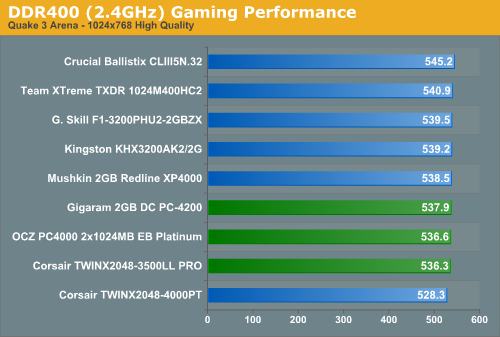
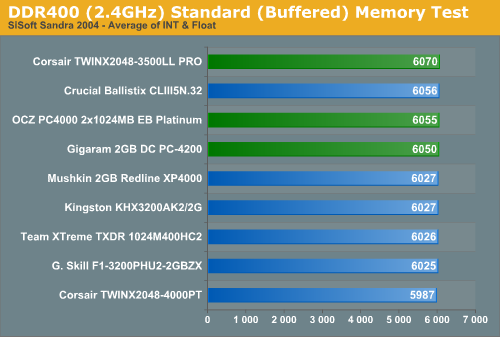
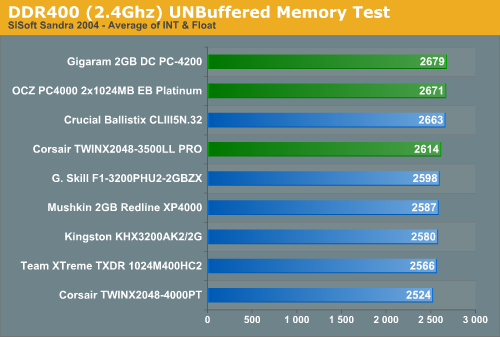
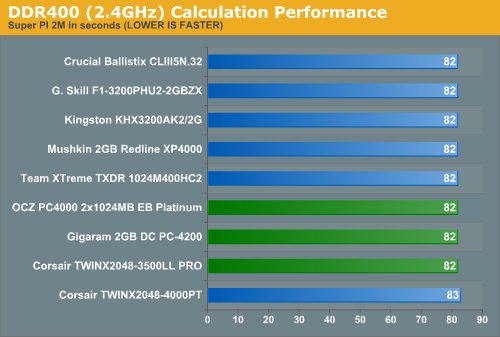
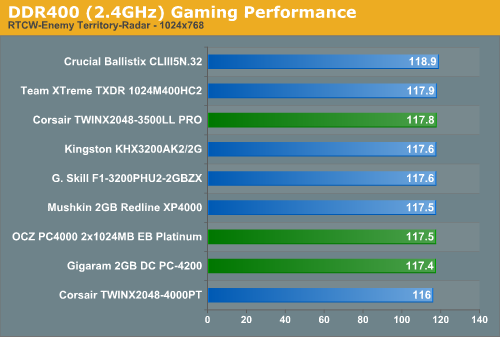
DDR436/2.4GHz Performance
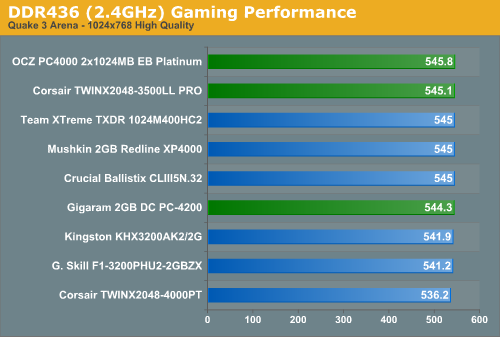
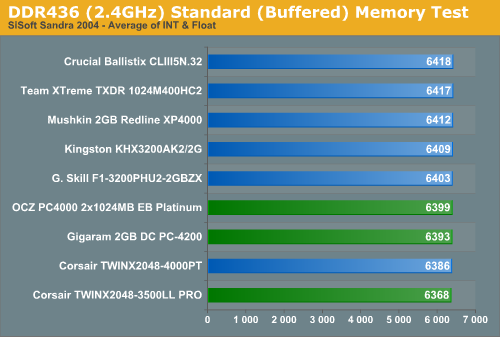
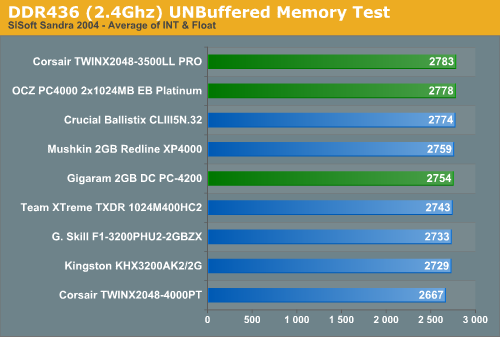
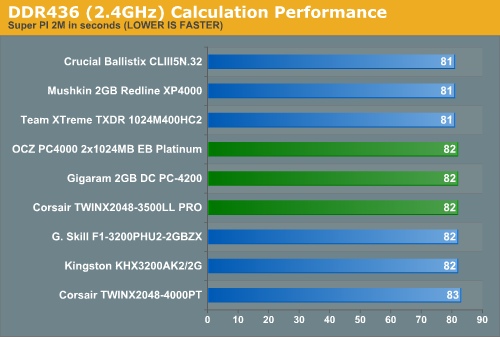
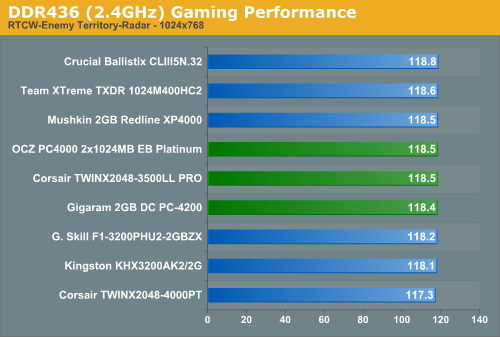
DDR480/2.4GHz Performance
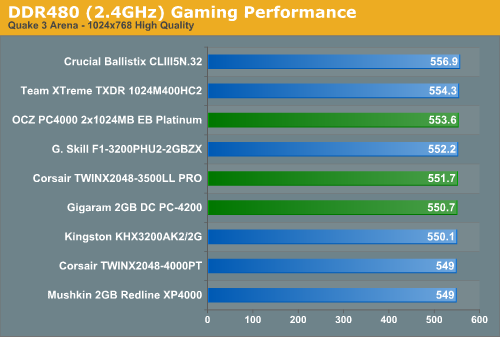
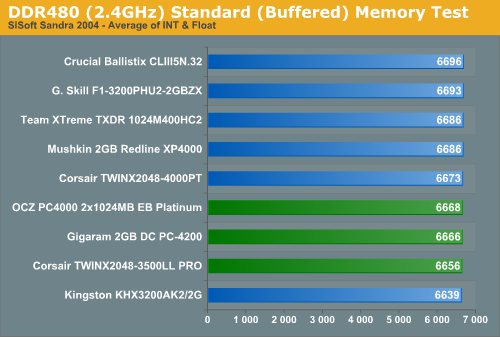
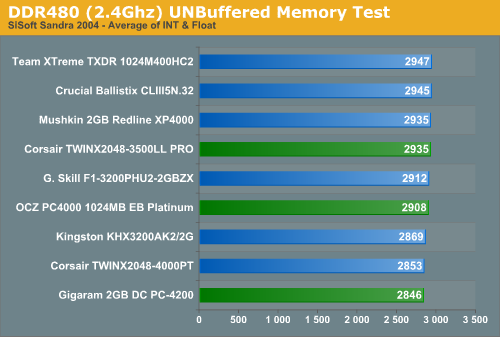
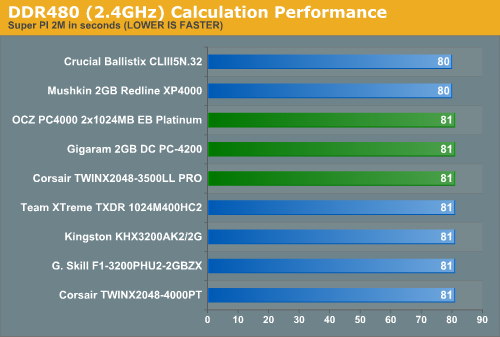
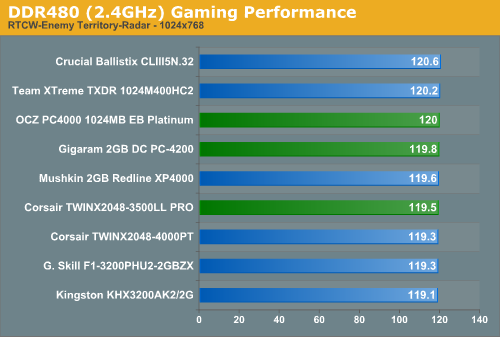
DDR533/2.4GHz Performance
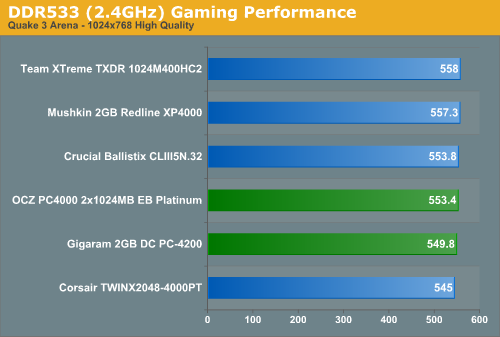
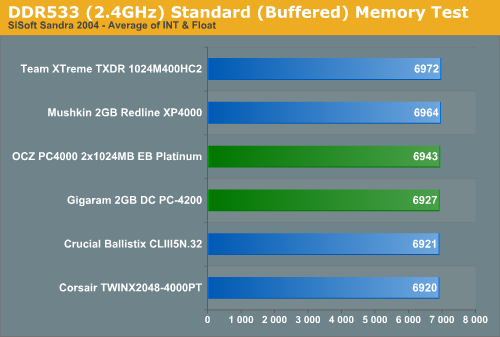
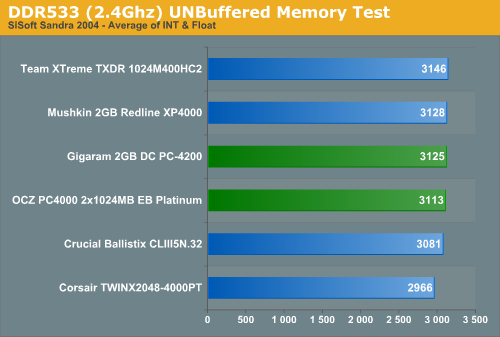
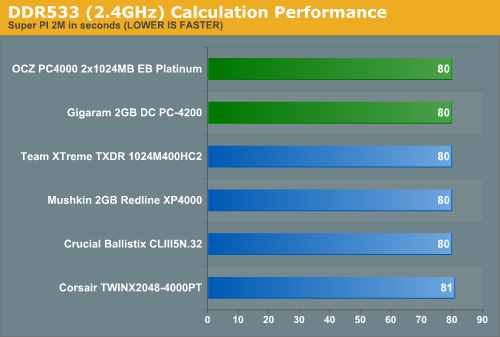
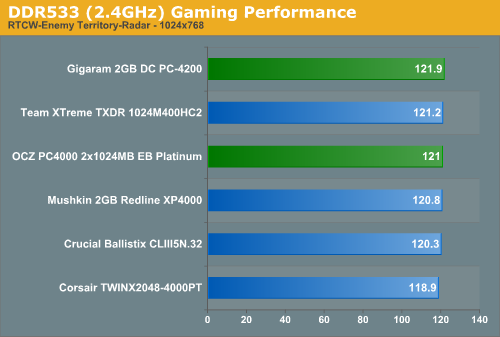
Highest Memory Performance
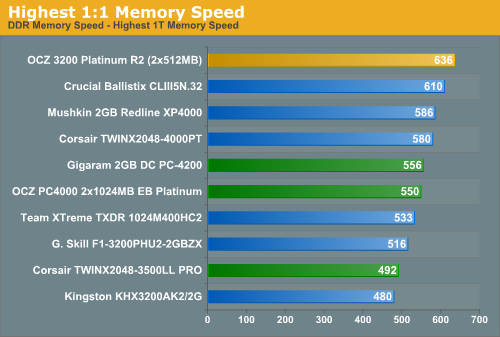
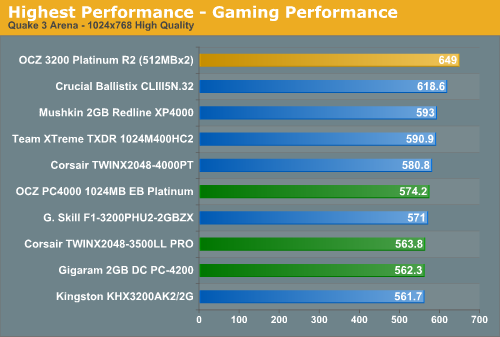
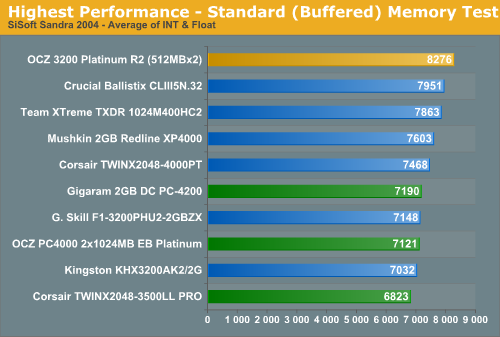
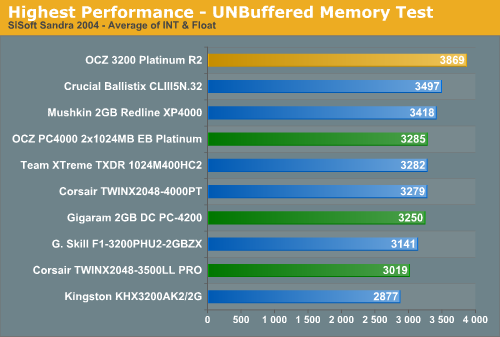
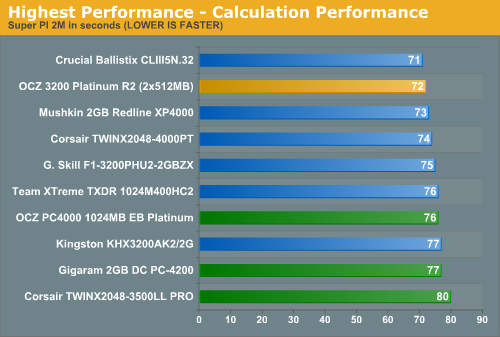
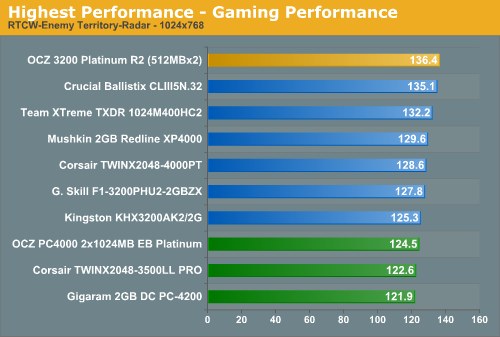
Final Words
Many seem confused as to whether it is best to use the fast 512MB DDR DIMMs or the now readily available 1GB DIMMs in their Athlon 64 system. Until recently, we advised buyers to go for the fast 512MB DIMMs, since those 2-2-2 timings on the low-latency A64 on-CPU memory controller usually provided better performance than the slower timings of the 1GB DIMMs. Even the comparison of 4 fast 2T Command Rate 512MB DIMMs versus 2 slower 1GB DIMMs at 1T usually showed that the fast 512MB timings more than offset the 2T penalty of 4 DIMMs.
In Part 1 of the 2GB Kit roundup, it was clear that those rules had changed. The new fast 1GB DIMMs were performing nearly as well as the fastest 512MB DIMMs, and this also made the 1T Command Rate advantage of 2 DIMMs real with 2x1GB DIMMs instead of 4x512MB DIMMs. In that Part 1, we concluded that we could now recommend 2GB kits to end-users. These six new 2GB kits reinforce that conviction - 2 GB has arrived as a real choice for the top-performing systems. All nine 2GB kits sporting a pair of 1GB DIMMs performed very well and with complete stability in our benchmarks. If your needs are fast performance at DDR400 to DDR480, then any of the eight kits based on Infineon B die, C die or Micron memory chips will do the job very well. You can make the selection based on price. If your needs extend to overclocking at DDR550 or beyond, the kits based on Infineon C die or Samsung UCCC will meet your needs. That includes kits rated at DDR500/533 from Corsair, Crucial, Mushkin, OCZ and Gigaram. In this group, the Corsair UCCC value RAM does not perform quite as well as the Infineon-based modules, but at a much lower price with outstanding overclocking, the Samsung is still a great choice where price matters.
There is no doubt that the Crucial Ballistix 2GB bit is the best performing 2GB kit that we have ever tested. However, there are serious questions right now about whether you will be able to even buy this 2GB kit. Crucial tells us that the item is out of stock and they may not be bringing the kit back in stock as they concentrate on DDR2 for the upcoming AMD AM2 launch. End users are reporting that Crucial is telling them the product is End-of-Life and is no longer available. It's a real shame that we can't direct you today to where to buy this excellent memory, and it is even more puzzling that Crucial/Micron may be discontinuing the best 2GB kit that we have ever tested. DDR memory will be useful in AMD platforms for at least another year and a half, and the 2GB Crucial kit would have been a wonderful choice for those who do not plan to migrate to DDR2 when AM2 is launched. We don't even know for sure, at this point, how DDR2 will actually perform with the new AM2 processors.
Whatever the logic, we cannot in good conscious reward a Crucial product that you can't actually buy today. If it were still readily available, it would easily garner our Gold Editor's Choice award, but with no real assurances of continued supply, we can only suggest that you check with Crucial to see if they decide to continue this outstanding 2GB Ballistix kit.
 |
Reviewing 2GB kits that you can actually buy, we jointly award our Gold Editors Choice to Mushkin 2GB Redline XP4000 and OCZ PC4000 2x1024 EB Platinum. The OCZ earned our Gold Editors Choice Award in Part 1 of the roundup and its performance still holds up very well against the 2GB kits that you can actually buy. It is slightly faster than Mushkin Redline at the same test speeds, but the differences are not significant, and no more than you would expect as normal variation among the same memory chips. Mushkin Redline overclocks a bit further - to DDR586 compared to OCZ DDR550 - so if highest OC frequencies is your goal, the Mushkin may be a better choice. |
 |
Our Silver Editors Choice has more to do with value than performance. Corsair's TWINX2048-4000PT is the only memory in this roundup based on Samsung UCCC memory chips. While the Corsair must run at slower memory timings, the real differnce in performance is fairly small. In the important overclocking area, the Corsair 4000PT is an excellent performer, reaching a stable overclock of DDR580. This is as good as any memory in this roundup and better than almost all the other 2GB kits. With the same overclocking abilities as the best Infineon and only a slight performance penalty from slower timings, the 30-40% price reduction will be an acceptable trade-off for many end-users. For the excellent value and superb overclocking offered by the Corsair TWINX2048-4000PT, we are pleased to award the AnandTech Silver Editors Choice. |
We should also mention that Samsung UCCC 2GB kits are available from OCZ and some other Enthusiast memory manufacturers. The OCZ parts are PC4000 Gold and PC4000GX XTC, and they are about the same price as the Corsair kit. We have not tested either OCZ UCCC, but with the same memory chips, performance should be similar.
All nine of the 2GB DDR kits performed very well in our tests. You should keep in mind, however, that 1GB DIMMs are much more demanding of a memory controller and the motherboard than 512MB parts. For that reason, we would strongly recommend that those who plan high overclocks with 1GB DIMMs use a CPU with a recent Rev. E or better memory controller. The more recent on-chip controllers handle the demands of 1GB memory modules better than older clawhammer controllers.
Last, we will try to answer the question again about whether two 1GB or four 512MB DIMMs are the better choice for Athlon 64 DDR memory. If you plan to install 4GB of memory or upgrade to 4GB in the near future, then 1GB DIMMs are your only choice on current motherboards. There is also no doubt that fast 1GB DIMMs, like eight of the 9 kits tested here, remove the complaint that 1GB DIMMs are slower and will compromise performance compared to fast 512MB DIMMs. There are still a few 512MB DIMMs that top the performance list, but the eight fastest 2GB kits tested here are extremely close to the very best 512MB memory in performance. Even the value Corsair 4000PT was quite close in performance to the other DIMMs and still overclocked well - so price is also no longer a major issue for 1GB DIMMs.
If we were building an AMD Athlon 64 system today, we would definitely choose a 2GB kit for memory. It finally makes sense to choose a 2GB kit and our Editors Choices in this roundup should help in your buying decision. 2GB also makes sense for the OS future. With Vista coming and 2GB, the new memory recommendation for the new OS, you will be set for Vista.
The only real question is whether you really want to invest in 2GB of DDR with AMD DDR2 just around the corner. We don't think that you can possibly lose choosing one of these excellent 2GB kits for your new system build today, but you will need new DDR2 memory for AM2 when it arrives in a few months. What we don't yet know is whether AM2 or the upcoming Intel processors will provide the kind of compelling performance that will make an upgrade to DDR2 a performance enhancing choice for your new system. We look forward to finding answers to this question in the near future.







